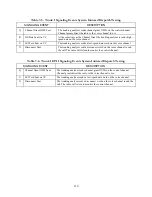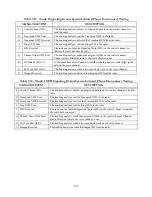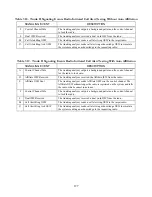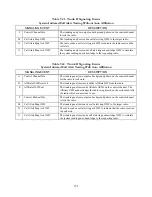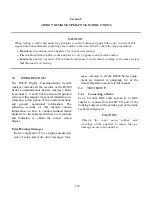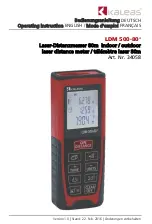
7-3.3
System Initiated Phone Interconnect
Test Sequence, Trunk I and
Trunk I EP II Signaling
Configure the analyzer for trunk mode (paragraph
6-5) and System Initiated Testing (paragraph 6-7).
NOTE
Fleet, Subfleet, and Unit ID information must
be entered before the execution of a System
Initiated test. If a Radio Initiated test is
executed prior to the System Initiated test,
these fields are automatically updated. If
required, refer to paragraph 6-8.1 for in-
formation related to entry and storage of sys-
tem/fleet map configurations.
1.
Enter the following parameters:
Sig Type:
Trunk I or Trunk I EP II
ID Disp:
HEX or DEC
Call Seq:
PHONE INTERCONNECT
2. Set the System ID to match the radio system ID
and one of the system IDs in the Radio
Configuration screen.
NOTE
The System ID entered must match the System
ID of the radio. Otherwise the radio will not
lock onto the control channel. Refer to
paragraph 6-8, Radio Configuration.
3. Enter Fleet, Subfleet, and Unit ID.
4. Enter the CCTx or Control Channel number.
Enter the VCTx or voice channel number.
NOTE
Splinter channels can only be entered by
frequency. Standard channels can be entered
by frequency or channel number (channel
numbers only map to standard channel
frequencies).
5. Set the monitor attenuation and port selection.
Suggested port selection is RF I/O with 20 dB
attenuation.
6. Set the generator attenuation and port selection.
Suggested port selection is RF I/O with -50 dB
for the level setting.
7. Press the start test softkey.
The trunking analyzer generates an idle OSW
pattern for the radio to lock to. After a short
period of time, the analyzer will send a
message to the radio instructing it to ring. The
radio sends a message to the analyzer when the
call has been answered. At that time, the
analyzer directs the radio to a voice channel
and provides the appropriate Trunk I or Trunk I
EP II handshake.
8. The status thermometer displays the major
signaling events that occur during a system
initiated phone interconnect test. Refer to
table 7-13 (Trunk I signaling) or table 7-14
(Trunk I EP II signaling).
Once on the voice channel, the operator can
modulate the carrier with tones, or voice, and
select other displays.
9. To complete the last step on the status
thermometer and end the test sequence, the
operator must return to the System Init
selection. From the "Meter:" cursor position,
the operator completes the test sequence by
pressing the
hangup
softkey.
The trunking analyzer prompts the user to hang
up the phone. When the analyzer detects that
the phone has been hung up, the status
thermometer is updated, the ISW decode field
is updated, and the test ended message is
displayed on the screen.
121
Summary of Contents for R2600 Series
Page 8: ...3 7 1 3 AC DC Voltmeter 41 3 7 1 4 INT DIST EXT DIST Meter 43 v...
Page 46: ...This Page Intentionally Left Blank xxxvi...
Page 66: ...DISPLAY ZONE RF ZONE AUDIO ZONE Figure 3 1 Screen Zone Arrangement 20...
Page 68: ...Figure 3 2 System Help 22...
Page 83: ...Figure 3 11 General Sequence Mode Select 37...
Page 85: ...39 Figure 3 12 RF Display Zone...
Page 88: ...Figure 3 14 Digital Voltmeter Screens 42...
Page 102: ...Figure 3 22 Bar Graphs 56...
Page 107: ...Figure 3 24 Memory Screens 61...
Page 128: ...This Page Intentionally Left Blank 82...
Page 202: ...This Page Intentionally Left Blank 156...
Page 205: ...Figure 11 1 R 2670 with SECURENET Option Housing 159...
Page 206: ...This Page Intentionally Left Blank 160...
Page 218: ...Figure 13 8 Test Key Programming Display Figure 13 9 External Key Programming Display 172...
Page 225: ...Figure 13 12 Duplex Mode Display Zone 179...
Page 234: ...VOICE Figure 13 17 CLEAR SCOPE Markers 188...
Page 236: ...This Page Intentionally Left Blank 190...
Page 249: ...Figure 14 8 SECURENET CLEAR SCOPE Display of Output Modulation 203...
Page 252: ...This Page Intentionally Left Blank 206...
Page 256: ...210 This Page Intentionally Left Blank...
Page 267: ...Figure 17 7 Encryption Select Display Figure 17 7 Encryption Select Display 221 221...
Page 286: ...This Page Intentionally Left Blank 240...
Page 291: ...Figure 18 1 Radio BER Test Mode Audio Zone Figure 18 2 Radio BER Test Mode BER Meter 245...
Page 293: ...Figure 18 4 Receive BER 247...
Page 298: ...Figure 18 6 ASTRO CLEAR SCOPE Display of Output Modulation 252...
Page 304: ...Figure 21 1 PROJ 25 Version Screen Figure 21 2 PROJ 25 Options Screen 258...
Page 309: ...Figure 21 6 SET UP Display Screen Figure 21 7 Encryption Select Display 263...
Page 335: ...Figure 22 4 PROJ 25 CONV CLEAR SCOPE Display of Output Modulation 289...
Page 339: ...Figure 24 1 PROJ 25 Version Screen Figure 24 2 PROJ 25 Options Screen 293...
Page 354: ...Figure 25 3 Encryption Select Display Figure 25 4 Algorithm Select Display 308...
Page 369: ...B 6 This Page Intentionally Left Blank...
Page 379: ...This Page Intentionally Left Blank F 4...
Page 383: ...This Page Intentionally Left Blank H 2...
Page 389: ...J 4 This Page Intentionally Left Blank...
Page 393: ...This Page Intentionally Left Blank K 4...








